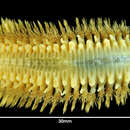en
names in breadcrumbs


“1. HARMOTHOË SPINOSA.
(Pl. X LI., figs. 1-4, and Pl. XLIII., figs. 1-2 and 4-8.)
Harmothoë spinosa, Kinberg, J. G. H., 1855. Ofv. Ak. Forh., Stockholm, p. 386. Id., 1857. ‘Eugenics Resa,’ p. 21, Taf. VI., fig. 31. Ehlers, E., 1897, Polychaeten, Hamburg. Magalhaens. Sammebreise, p. 12.
This species seems to be the representative, in the Antarctic regions, of the northern species H. imbricata (L.), the principal difference between them, so far as I can ascertain by comparison of specimens, relating to the situs oculorum. In the Antarctic species the four eyes are visible from above, while H. imbricata, as pointed out by McIntosh,1 shows only a single pair of eyes in dorsal view, the anterior pair being concealed below the frontal cones. Both species present a very great range of variation in the fimbriation and pigmentation of the elytra, which has been alluded to by Ehlers (1897) and McIntosh (1900).
The number of segments, including the buccal segment, frequently adds up to thirty-seven, but this number possibly represents a particular condition in which the worms are commonly taken, and may not have the significance of a fixed quantity. In one case twenty normal segments are followed abruptly by twelve to thirteen small regenerated segments ; another specimen of 40 mm. has thirty-eight segments ; in a third specimen of 33 mm. the segments, thirty-four in number, taper to a point behind, but no anal cirri are present.2
Judging from the material at my disposal, the variations would seem to culminate in three principal allotypic modifications, of which a brief description follows. One of these modifications is for the present retained as a distinct species (see p. 266).
1McIntosh, W. C., 1900: ' British Annelids,' Ray Soc. Monograph, p. 316.
2 Ehlers (1897) finds thirty-seven segments with length of body increasing from 12 to 45 mm. In this connection it is interesting to note that the number of segments in Lagisca vesiculosa is given both by Grube (1877) and Ehlers (1897) as forty-two. Grube's specimen was 21 mm. in length ; Ehlers gives no dimensions. The larger ‘Challenger’ specimens (named L. antarctica, McInt.), measuring up to 36 mm. in body-length, have no more than thirty-nine segments. The number forty-two may very well be final, in which case it will be interesting to learn how it happens that some individuals have less than the normal number of segments, while others nearly half the size have the full complement.”
(Willey, 1902)